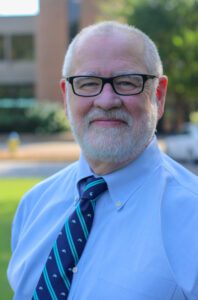
Diversity, equity, and inclusion should be woven throughout every aspect of academia, whether that is the people themselves, curriculum, or research. This is the purpose of Goal 3 in the College of Communication and Information’s Strategic Plan, which seeks to “Progress and sustain a nurturing college culture where diversity, equity, inclusion, and community are enduring sources of strength and core tenets in developing the next generation of Vols.”
Developing DEI expertise in everything CCI faculty, staff, and students do is critical to the college’s future, said Professor Vandana Singh, who is CCI’s director of diversity, equity, and inclusion. That’s why research such as Michael Martinez’s, assistant professor of practice for the School of Journalism and Electronic Media, is so important. Martinez is utilizing a grant from CCI’s Research and Innovation Center to lay the foundation for his latest project: “Voces en la mesa (Voices at the Table): Hispanic Journalists Oral History Project.” The research will record interviews of Hispanic journalists and the effect their roles played in media coverage of the Latin community.
“Dr. Martinez’s research is a perfect example of the Volunteer Spirit and demonstrates how important it is to teach our students to think inclusively when they leave, enter their careers, and create the future workforce,” Singh said.
Hispanic Voices
Martinez said this research grew out of his experience as a journalist at a variety of outlets, including the Associated Press in New York, the Louisville Courier-Journal, the Detroit News, the Cincinnati Enquirer, and the Fort Worth Star-Telegram. In 1978, the American Society of News Editors (ASNE) challenged the news industry to diversify their newsrooms and achieve racial parity by 2000.
“With constriction of media and the closing of newspapers, I started looking at and wondering, where is this line now? Is there still diverse representation in newsrooms? Is that goal falling to the wayside because of economic pressures?” he said. “The [news outlets’] goal every year was diversity, but there’s conflicting values because it’s driven by where they’re going to sell their advertising, and by their market. There’s stated goals, but is it just numbers, tokenism in effect? Or is there really influence?”
Martinez wants to better understand if Hispanic journalists are able to tell stories that reflect their perspectives and serve Latino communities, or if those journalists are still functioning without influence in a majority white industry. While studies have been done about Hispanic journalists and their representation in newsrooms, Martinez realized he would need to go straight to the source and record the oral histories of Hispanic journalists. This project has three prongs:
- Create a website of the oral histories for general consumption by the public;
- Establish a repository at the UT Libraries so other scholars can access and use data from the project;
- And complete a book based on the oral histories.
Martinez was accepted at the Voces Oral History Research Summer Institute at the University of Texas at Austin in summer 2022, which helped him create these three prongs. Funding from the Summer CCI Research and Innovation Projects Support (SCRIPS) grant supplied equipment Martinez will use to record the oral history interviews. He is applying for a National Endowment Humanities grant he hopes will fund the rest of this project.
Hispanic Voices
A lack of Hispanic representation in newsrooms and in journalism history is a topic very familiar to Martinez’s colleague, Melita Garza, associate professor at the University of Illinois, Urbana-Champaign’s Department of Journalism. Garza knows Martinez through her position as current chair of the Association in Journalism and Mass Communication (AEJMC) committee on standing research, and through her previous position as book review editor for Journalism History.
Garza said there is a lack of public understanding about the history and role of Latinos in North America, and particularly of the role Hispanic journalists and media have played in this region throughout history. It is a cycle that continues, as she said the experiences of modern-day Hispanic journalists and communities are still muted in media. Latinos are the largest ethnic racial group in the country, comprising almost 20-percent of the population, yet that is not reflected in the newsroom numbers—especially within leadership.
Not only are newsrooms lacking in diversity, but so is academia and research, Garza said. She noted that fewer than three-percent of all PhD degree holders are Hispanic, and that number narrows more within the field of journalism and media studies. This affects how much research is conducted around the history of Hispanic journalism and media.
“It’s a compounding problem because the people making decisions about what are the top books, what are the top journal articles, what’s going to get published, will bring some of the same obliviousness and ignorance about the importance and significance of Latinos in this country, and also to journalism history,” Garza said.
Martinez said he’s observed the disparity in news coverage of the growing Hispanic population in Knoxville. The only time he’s seen news about the Latino community in Knox County is when there is a festival centered around them.
“My gut instinct is that, with the contraction of the media and numbers of media staff, the goal of diversity may still be there. But I don’t know if the influence is there, if the voices at the table are there anymore,” he said.
Adding these voices to journalism history and research is invaluable, Garza said. A recent survey of Journalism History, one of two major publications for journalism historians, revealed that of 722 research essays in 47 volumes, 19 were related to Hispanic and Latino issues; a number Garza called “an infinitesimal percentage.”
“This is really emblematic of the huge need for the kind of research that Dr. Martinez is working on. We need 300 Dr. Martinezes so we can try to catch up,” she said.
